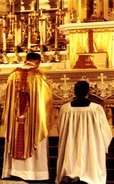The Byzantine Divine Liturgy has three parts: the preparation of the priest and the gifts of bread and wine (prothesis); the liturgy of the catechumens (liturgy of the word); and the liturgy of the faithful.
A. The preparation of the gifts has two parts. First, the preparation of the priest, which includes the prayers and his clothing with the sacred vestments. In the prayers the priest asks the Lord in his mercy to make him worthy to offer the sacrifice, to intercede for the people, to call down the Holy Spirit.
There follows the preparation of the gifts of bread and wine. Although the rite of preparation is performed by the priest alone, the whole Church, in heaven and in earth, is symbolically present.
B. The liturgy of the catechumens calls for the participation of the catechumens, who are then dismissed after the proclamation of the Gospel.
The Divine Liturgy begins with an invocation of the Holy Trinity: “Blessed be the kingdom of the Father and the Son and the Holy Spirit…”. Three litanies follow, a longer one and two shorter ones, which invoke the Lord’s mercy upon the whole world and the entire Church. Mention is made of the Church, her members and all those in need. These litanies always include an invocation to the Mother of God, who intercedes for everyone and for the Holy Church. After the second litany the christological hymn, “Only-Begotten” is sung; this is an ancient liturgical hymn that summarizes the principal dogmas of the Christian faith: the Trinity, the Incarnation of the Word of God, the divine maternity of Mary, the salvation that is bestowed on us by Christ’s passion, death and resurrection. There follows the “Small Entrance”. In a solemn procession, the priest and the deacon take the Gospel from the altar, show it to the faithful and set it again on the altar, in order to indicate the beginning of the proclamation of the word of God: originally this was the entrance procession. Before the readings the Trisagion is chanted: “Holy God, Holy Mighty, Holy Immortal…”. Two readings are then proclaimed from the New Testament. The Gospel is usually followed by a homily.
C. The Liturgy of the Faithful. The third part of the Divine Liturgy is the liturgy of the faithful, in which those who are baptized participate fully. It begins with the “Great Entrance”, the procession with the bread and wine towards the altar. The choir sings the hymn: “We who mystically represent the Cherubim…”, another ancient liturgical text in which the Church of heaven and earth is united in praise and thanksgiving to God for his gifts. The priest incenses the altar, the church, the gifts and the faithful, all of which are icons of Christ. He then solemnly takes the paten and the chalice, and after asking the Lord to remember all those who have been commemorated and the whole Church, he sets them on the altar and covers them with the veil. The priest then recites for himself and the whole Church the words of the Good Thief from his cross: “Remember me, Lord, in your Kingdom…”. The gifts, a symbol of Christ, the Lamb who was slain, are then placed on the altar, as if in the tomb from which, after the consecration or sanctification, the life-giving Body of Christ will be given to each of the faithful. After the entrance, litanies are sung, the sign of peace is exchanged, and the Nicene-Constantinopolitan Creed is recited. There follows the anaphora of Saint John Chrysostom, which has a structure similar to that of the other anaphoras of the Eastern and Western liturgies: an initial trinitarian dialogue, Preface, Sanctus, anamnesis, institution narrative, epiclesis, intercessions and conclusion.
This is followed by the Our Father, the breaking of the bread and communion. Before communion the priest pours some boiling water (called the zéon) into the chalice as a symbol of the outpouring and presence of the Holy Spirit, as well as a sign of the life which comes from communion in the living and life-giving Body and Blood of Christ himself. Communion is received under both species.
The Divine Liturgy concludes with the final blessing.
The Liturgy of the Word in the Armenian Apostolic Cathedral of Saint Mary
The prayers and ritual sequences making up the prayer service have been drawn from various elements of the Eucharistic celebration of the Armenian Liturgy.
Before the entrance procession in the Cathedral, in accordance with the Armenian national tradition, the Holy Father is presented with bread, salt and rose water as symbols of welcome and good wishes.
As His Holiness and His Beatitude enter the Cathedral, the choir performs the chant Herasciapar Asdvadz (“O Wondrous God”), which recounts the story of the conversion of the Armenian people to Christianity through the efforts of Saint Gregory the Illuminator.
At the foot of the altar, a prayer is said. The Holy Father and His Beatitude then take their places before the sacred altar, from which the Gospel, carried in procession from the entrance of the Cathedral, is solemnly proclaimed.
The prayer service in the Armenian Apostolic Cathedral expresses the joy of the Armenian Apostolic Church at the visit of His Holiness Pope Benedict XVI.



No comments:
Post a Comment